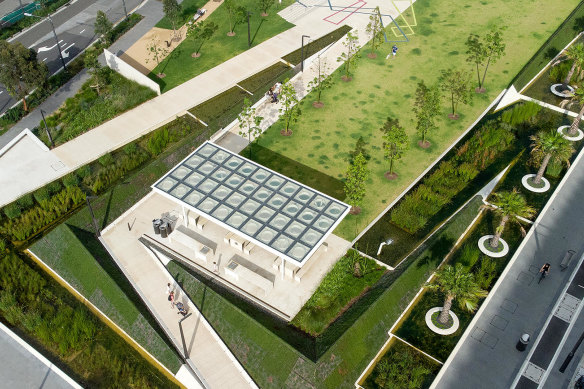Save articles for later
Add articles to your saved list and come back to them any time.
For 200 years, Sydney’s Green Square often flooded. It was also where wool was washed, and hung out in fluffy piles to dry, polluting local waterways.
Now the 6400 square metre Drying Green Park has won the Australian Institute for Landscape Architects’ 2023 award for infrastructure.
The Drying Green by McGregor Coxall with the City of Sydney and Regal Innovations. The Australian Institute of Landscape Architects will announce the winners of the National Awards.
Inspired by origami, the green is an “ecological engine” engine that washes and dries.
The jury of the AILA awarded the prize to landscape architects McGregor Coxall, alongside the City of Sydney and Regal Innovations.
It said the equivalent of an Olympic pool of polluted water is drawn from a drain flowing deep beneath the site (the former Sheas Creek) and cycled through the wetland. Every three days clean water is returned to Alexandra Canal.
It is the type of innovation and multidisciplinary solution that brings joy to visiting American landscape architect Kate Orff, one of Time magazine’s 100 most influential people this year.
Landscape architect Kate Orff is in Sydney to receive the fifth OBEL Award architecture prize for innovation in the built environment. Credit: Cassandra Hannagan
Orff is best known for her ‘Oyster-tecture’, the use of bivalves to create natural breakwaters, restore marine biodiversity and protect the shore from epic storms that are increasing with climate change.
Speaking at the Danish consulate in Sydney, Orff talked about the Living Breakwaters project off Staten Island in New York. The project by Orff with a team of others received the fifth annual OBEL Prize for architecture.
Orff, the founder of SCAPE, outlined her credo that architects needed to move away from “making beautiful things and scenery to being about change.”
These were pearls to Peta-Maree Ashford, the president of AILA, which announced its winners on Thursday.
Ashford said: “Just to be clear, we don’t just design pretty gardens. We combat climate change, we are looking at social history. We think we are seriously the rock stars of the industry,” said Ashford. She said the profession was guided by science, worked in teams with experts, such as hydrologists, considered heritage, and consulted locals.
In Queensland, the Hanlon Park/Bur’uda Waterway Rejuvenation won three awards for returning nature to inner-city Brisbane. It transformed a “concrete lined channel” into a place of joy and wildness, the jury said.
By Brisbane City Council, Tract, Bligh Tanner, Epoca Constructions, and AECOM, Hanlon Park project won three awards: for climate positive design, best open spaces and land management.
It used historical flood mitigation practices, engaged with the Nunukul Yuggera people, maximised the retention of trees for carbon sequestration; material was salvaged and reused; there was extensive canopy and understorey planting; and it fostered active transport connections.
Orff said landscape designers worked with so many other disciplines, they were like a “visionary coordinator”.
The Australian award, the President’s Prize, was awarded to Fiona Morrison, the commissioner of Open Space and Parks at the NSW’s Department of Planning Environment, for her leadership.
She was inspirational, said Ashford, and had encouraged the establishment of pathways for ecological restoration and environmental reconciliation.
Orff was included in Time magazine’s list of 2023 most influential people, and has been profiled in magazines from Oprah to the New Yorker.
She said prizes for landscape architects for projects like Living Breakwaters highlighted the need to protect natural systems that were declining because of climate change.
“We have to work fast and work together.”
She said: “Landscape architecture is still a bit in the background of the design field. And I do feel that whatever I can do to foreground it, is good.”
Orff’s project Living Breakwaters is a one kilometre necklace of near-shore breakwaters along the south shore of Staten Island in New York.
The Obel Award citation says it uses a mix of stones and concrete units to calm the water, reduce erosion, and rebuild onshore beaches, and support oysters, fin fish, and other marine species. The oysters will form part of the design of the artificial reef formation.
As they reproduce, the breakwaters grow denser and protect the shore.
Orff said building healthy interconnected landscape architecture is something that was hard to visualise. Often awards “were given to projects that fit nearly into a photograph,” she said.
Other winners of the Australian Landscape awards include the Cape Solander Whale Watching Facilities by OCULUS with NSW National Parks and Wildlife Service which won the tourism award. .
Long Reef Surf Life Saving Club Courtyard-by TYRRELLSTUDIO won the small projects category.
Founded by the late businessman Henrik Frode Obel, the international OBEL prize recognises a project in the built environment rather than an individual. Each year has a different theme.
At 100,000 euros, it is one of the richest prizes in the world. In contrast, the Australians winners of the national awards receive a certificate.
Obel was a friend of Jorn Utzon, the architect of the Sydney Opera House which this year turns 50.
Start the day with a summary of the day’s most important and interesting stories, analysis and insights. Sign up for our Morning Edition newsletter.
Most Viewed in National
From our partners
Source: Read Full Article




